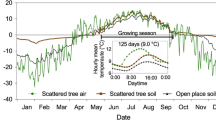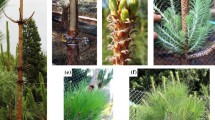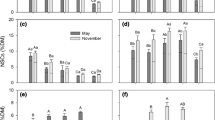Abstract
In frequently burnt savannas, saplings face the formidable challenge of both recovering from, and eventually growing tall enough to escape from, frequent fire damage. The aim of this study was to explore how saplings allocate carbon to achieve these ends through carbon partitioning, storage and remobilization. Lignotuber total non-structural carbohydrate (TNC) concentrations and δ13C values of Acacia karroo (Fabaceae; Mimosoideae) were determined in plants from two different juvenile stages. These were one year after a fire when the plant consisted of numerous leafy shoots or coppices (“coppicing” stage), and three years after a fire when the plant consisted of one pole-like stem (“Gulliver” stage). Gulliver lignotubers were found to have significantly larger TNC pools (150 g vs. 97 g) and larger TNC concentrations (33% vs. 24%, w/w) than coppice lignotubers showing that post-coppice Gullivers recharged TNC in the lignotuber. δ13C values from the stems of plants in the Gulliver stage were significantly enriched (>1‰) in 13C compared to both coppicing (P < 0.01) and adult (P < 0.05) plants. Changes in both the amount of stored carbon and in the δ13C values indicated dependence on stored carbon reserves, and partially heterotrophic growth for initial resprouting. The plants appeared to use both current photosynthate and stored carbon reserves for growth of the Gulliver stem. The use of stored carbon is hypothesized to promote fast stem growth rates to a height where saplings escape fire injury.






Similar content being viewed by others
References
Archibald S, Bond WJ (2003) Growing tall vs. growing wide: tree architecture and allometry of Acacia karroo in forest, savanna, and arid environments. Oikos 102:3–14. doi:10.1034/j.1600-0706.2003.12181.x
Badeck FW, Tcherkez G, Nogués S, Piel C, Ghashghaie J (2005) Post-photosynthetic fractionation of stable carbon isotopes between plant organs—a widespread phenomenon. Rapid Commun Mass Spectrom 19:1381–1391. doi:10.1002/rcm.1912
Balfour DA, Howison OE (2001) Spatial and temporal variation in a mesic savanna fire regime: responses to variation in annual rainfall. Afr J Range Forage Sci 19:43–51
Bell TL, Ojeda F (1999) Underground starch storage in Erica species of the Cape Floristic Region- differences between seeders and resprouters. New Phytol 144:143–152. doi:10.1046/j.1469-8137.1999.00489.x
Bell TL, Pate JS (1996) Growth and fire response of selected Epacridaceae of South Western Australia. Aust J Bot 44:509–526. doi:10.1071/BT9960509
Bell TL, Pate JS, Dixon KW (1996) Relationships between fire response, morphology, root anatomy and starch distribution in South-West Australian Epacridaceae. Ann Bot (Lond) 77:357–364. doi:10.1006/anbo.1996.0043
Bellingham PJ, Sparrow AD (2000) Resprouting as a life history strategy in woody plant communities. Oikos 89:409–416. doi:10.1034/j.1600-0706.2000.890224.x
Boaler SB (1966) The ecology of Pterocarpus angolensis in Tanzania. Overseas Research Publication 12. Ministry of Overseas Development, London
Bond WJ, Midgley GF (2000) A proposed CO2-controlled mechanism of woody plant invasion in grasslands and savannas. Glob Change Biol 6:865–869. doi:10.1046/j.1365-2486.2000.00365.x
Bond WJ, Midgley JM (2001) The persistence niche: ecology of sprouting in woody plants. Trends Ecol Evol 16:45–51. doi:10.1016/S0169-5347(00)02033-4
Bond WJ, Midgley JM (2003) The evolutionary ecology of sprouting in woody plants. Int J Plant Sci 164(3):S103–S114. doi:10.1086/374191
Bond WJ, van Wilgen BW (1996) Fire and plants. Chapman and Hall, London
Bowen BJ, Pate JS (1993) The significance of root starch in post-fire shoot recovery of the resprouter Stirlingia latifolia R.Br. (Proteaceae). Ann Bot (Lond) 72:7–16. doi:10.1006/anbo.1993.1075
Brugnoli E, Farquhar GD (2000) Photosynthetic Fractionation of Carbon Isotopes. In: Leegood RC, Sharkey TD, von Caemmerer S (eds) Photosynthesis: Physiology and Metabolism. Kluwer Academic Publishers, Netherlands, pp 399–434
Brugnoli E, Hubick KT, von Caemmerer S, Wong SC, Farquhar GD (1988) Correlation between the carbon isotope discrimination in leaf starch and sugars of C3 plants and the ratio of intercellular and atmospheric partial pressures of carbon dioxide. Plant Physiol 8:1418–1424
Buysse J, Merckx R (1993) An improved colimetric method to quantify sugar content of plant tissue. J Exp Bot 44(267):1627–1629. doi:10.1093/jxb/44.10.1627
Canadell J, López-Soria L (1998) Lignotuber reserves support regrowth following clipping of two Mediterranean shrubs. Funct Ecol 12:31–38. doi:10.1046/j.1365-2435.1998.00154.x
Chirara C, Frost PGH, Gwarazimba VEE (1998) Grass defoliation affecting survival and growth of seedlings of Acacia karroo, an encroaching species in southwestern Zimbabwe. Afr J Range Forage Sci 15:41–47
Cruz A, Moreno JM (2001) Seasonal course of total non-structural carbohydrates (TNC) in the lignotuberous Mediterranean-type shrub Erica australis. Oecologia 128:343–350. doi:10.1007/s004420100664
Cruz A, Pérez B, Moreno JM (2003) Resprouting of the Mediterranean-type shrub Erica australis with modified lignotuber carbohydrate content. J Ecol 91:348–356. doi:10.1046/j.1365-2745.2003.00770.x
Damesin C, Lelarge C (2003) Carbon isotope composition of current-year shoots from Fagus sylvatica in relation to growth, respiration and use of reserves. Plant Cell Environ 26:207–219. doi:10.1046/j.1365-3040.2003.00951.x
Dawson TE, Mambelli S, Plamboeck AH, Templer PH, Tu KP (2002) Stable isotopes in plant ecology. Annu Rev Ecol Syst 33:507–559. doi:10.1146/annurev.ecolsys.33.020602.095451
Ehleringer RE, Hall AE, Farquhar GD (1993) Stable Isotopes and Plant Carbon-Water Relations. Academic Press, San Diego
Erdmann TK, Nair PKR, Kang BT (1993) Effects of cutting frequency and cutting height on reserve carbohydrates in Gliricidia sepium (Jacq). Walp. For. Ecol. Manage 57:45–60. doi:10.1016/0378-1127(93)90161-F
Farquhar GD, Hubick KT, Condon AG, Richards RA (1989) Carbon isotope fractionation and plant water-use efficiency. In: Rundel PW, Ehleringer JR, Nagy KA (eds) Stable Isotopes in Ecological Research, Ecological Studies No. 68. Springer, New York, pp 21–40
Francey RJ, Farquhar GD (1982) An explanation of 13C/12C variations in tree rings. Nature 297:28–31. doi:10.1038/297028a0
Gessler A, Keitel C, Kodama N, Weston C, Winters AJ, Keith H et al (2007) δ13C of organic matter transported from the leaves to the roots in Eucalyptus delegatensis: short-term variations and relation to respired CO2. Funct Plant Biol 34:692–706. doi:10.1071/FP07064
Gessler A, Tcherkez G, Peuke AD, Ghashghaie J, Farquhar GD (2008) Experimental evidence for diel variations of the carbon isotope composition in leaf, stem and phloem sap organic matter in Ricinus communis. Plant Cell Environ 31:941–953. doi:10.1111/j.1365-3040.2008.01806.x
Gignoux J, Clobert J, Menaut JC (1997) Alternative fire resistance strategies in savanna trees. Oecologia 110:576–583. doi:10.1007/s004420050198
Gleixner G, Danier HJ, Werner RA, Schmidt HL (1993) Correlations between the 13C content of primary and secondary plant products in different cell compartments and that in decomposing Basidiomycetes. Plant Physiol 102:1287–1290
Gleixner G, Scrimgeour C, Schmidt HL, Viola R (1998) Stable isotope distribution in the major metabolites of source and sink organs of Solanum tuberosum L.: a powerful tool in the study of metabolic partitioning in intact plants. Planta 207:241–245. doi:10.1007/s004250050479
Helle G, Schleser GH (2004) Beyond CO2-fixation by Rubisco–an interpretation of 13C/12C variations in tree rings from novel intra-seasonal studies on broad-leaf trees. Plant Cell Environ 27:367–380. doi:10.1111/j.0016-8025.2003.01159.x
Higgins SI, Bond WJ, Trollope WSW (2000) Fire, resprouting and variability: a recipe for tree- grass coexistence in savanna. J Ecol 88:213–229. doi:10.1046/j.1365-2745.2000.00435.x
Hobbie EA, Werner RA (2004) Intramolecular, compound-specific, and bulk carbon isotope patterns in C3 and C4 plants: a review and synthesis. New Phytol 161:371–385. doi:10.1111/j.1469-8137.2004.00970.x
Hodgkinson KC (1998) Sprouting success of shrubs after fire: height-dependent relationships for different strategies. Oecologia 115:64–72. doi:10.1007/s004420050492
Hoffman WA, Orthen B, Franco AC (2004) Constraints to seedling success of savanna and forest trees across the savanna-forest boundary. Oecologia 140:252–260. doi:10.1007/s00442-004-1595-2
Hoffmann WA, Bazzaz FA, Chatterton NJ, Harrison PA, Jackson RB (2000) Elevated CO2 enhances resprouting of a tropical savanna tree. Oecologia 123:312–317. doi:10.1007/s004420051017
Jaggi M, Saurer M, Fuhrer J, Siegwolf R (2002) The relationship between the stable carbon isotope composition of needle bulk material, starch, and tree rings in Picea abies. Oecologia 131:325–332. doi:10.1007/s00442-002-0881-0
James S (1984) Lignotubers and burls–their structure and ecological significance in Mediterranean ecosystems. Bot Rev 50:225–266. doi:10.1007/BF02862633
Kagawa A, Sugimoto A, Makimov TC (2006) Seasonal course of translocation, storage and remobilization of 13C pulse-labeled photoassimilate in naturally growing Larix gmelinii saplings. New Phytol 171:793–804. doi:10.1111/j.1469-8137.2006.01780.x
Kays JS, Canham CD (1991) Effects of time and frequency of cutting on hardwood root reserves and sprout growth. For Sci 37(2):524–539
Kühn C, Barker L, Bürkle L, Frommer WB (1999) Update on sucrose transport in higher plants. J Exp Bot 50:935–953. doi:10.1093/jexbot/50.suppl_1.935
Maze KE (2001) Fire survival and life histories of Acacia and Dichrostachys species in a South African Savanna. Unpublished Master’s thesis, University of Cape Town
Menaut J, Gignoux J, Prado C, Clobert J (1990) Tree community dynamics in a humid savanna of the Cote-d’Ivoire: modelling the effects of fire and competition with grass and neighbours. J Biogeogr 17:471–481. doi:10.2307/2845379
Miyanishi K, Kellman M (1986) The role of root nutrient reserves in regrowth of two savanna shrubs. Can J Bot 64:1244–1248
Moleele NM, Ringrose S, Matheson W, Vanderpost C (2002) More woody plants? The status of bush encroachment in Botswana’s grazing areas. J Environ Manage 64:1244–1248. doi:10.1006/jema.2001.0486
O’Connor TG (1995) Acacia karroo invasions of grassland: environmental and biotic effects influencing seedling emergence and establishment. Oecologia 103:214–223. doi:10.1007/BF00329083
O’Leary MH (1981) Carbon isotope fractionation in plants. Phytochemistry 20(4):553–567. doi:10.1016/0031-9422(81)85134-5
O’Leary MH, Madhaven S, Paneth P (1992) Physical and chemical basis of carbon isotope fractionation in plants. Plant Cell Environ 15:1099–1104. doi:10.1111/j.1365-3040.1992.tb01660.x
Rundel PW, Ehleringer JR, Nagy KA (1989) Stable Isotopes in Ecological Research. Springer-Verlag, New York
Skowno AL, Midgley JJ, Bond WJ, Balfour D (1999) Secondary succession in Acacia nilotica (L.) savanna in the Hluhluwe Game Reserve, South Africa. Plant Ecol 145:1–9. doi:10.1023/A:1009843124991
Stott PA (1988) The forest as phoenix: towards a biogeography of fire in mainland South East Asia. Geogr J 154:337–350. doi:10.2307/634607
Sturm A, Tang GQ (1999) The sucrose-cleaving enzymes of plants are crucial for development, growth and carbon partitioning. Trends Plant Sci 4:401–407. doi:10.1016/S1360-1385(99)01470-3
Terwilliger VJ, Huang J (1996) Heterotrophic whole plant tissues show more 13C enrichment than their carbon sources. Phytochemistry 43(6):1183–1188. doi:10.1016/S0031-9422(96)00538-9
Trollope WSW (1984) Fire in Savanna. In: Booysen PdeV, Tainton NM (eds) Ecological effects of fire in South African ecosystems. Ecological studies 48. Springer-Verlag, Berlin, pp 149–176
Tschaplinski TJ, Blake TJ (1994) Carbohydrate mobilization following shoot defoliation and decapitation in hybrid poplar. Tree Physiol 14:141–151
Van der Heyden F, Stock WD (1996) Regrowth of a semiarid shrub following simulated browsing: the role of reserve carbon. Funct Ecol 10:647–653. doi:10.2307/2390175
Verdaguer D, Ojeda F (2002) Root starch storage and allocation patterns in seeder and resprouter seedlings of two Cape Erica (Ericaceae) species. Am J Bot 89:1189–1196. doi:10.3732/ajb.89.8.1189
Vesk PA, Westoby M (2004) Funding the bud bank: a review of the costs of buds. Oikos 106:200–208. doi:10.1111/j.0030-1299.2004.13204.x
Vigilante T, Bowman DMJS (2004) Effects of fire history on the structure and floristic composition of woody vegetation around Kalumburu, North Kimberley, Australia: a landscape-scale natural experiment. Aust J Bot 52:381–404. doi:10.1071/BT03156
Wahlenberg WG (1946) Longleaf pine: its Use, Ecology, Regeneration, Protection, Growth and Management. Charles Lathrop Pack Forestry Foundation, Wash. D.C
Acknowledgements
We thank KZN Wildlife for their support and provision of rainfall data for the Hluhluwe-Umfolozi Park and for allowing the research project to be undertaken in the park. Thanks to Krissie Krook and Mat Waldram for their logistical help in Hluhluwe-Umfolozi. The project was supported by funding from the National Research Foundation of South Africa and the Andrew Mellon Foundation. The experiments complied with current laws of South Africa.
Author information
Authors and Affiliations
Corresponding author
Rights and permissions
About this article
Cite this article
Wigley, B.J., Cramer, M.D. & Bond, W.J. Sapling survival in a frequently burnt savanna: mobilisation of carbon reserves in Acacia karroo . Plant Ecol 203, 1–11 (2009). https://doi.org/10.1007/s11258-008-9495-x
Received:
Accepted:
Published:
Issue Date:
DOI: https://doi.org/10.1007/s11258-008-9495-x




